The World after World War II | History - Cold War and its Strategies | 12th History : Chapter 15 : The World after World War II
Chapter: 12th History : Chapter 15 : The World after World War II
Cold War and its Strategies
Cold War
On 16 April 1947 Bernard Baruch, the US
Presidential adviser, in a speech at the State House in Columbia, used the term
"Cold War," (earlier coined by George Orwell, the great English
writer and author of Animal Farm), to
describe the relations between the United States and the Soviet Union after the
Second World War. A war without weapons, the Cold War was a war of ideologies.
Between 1945 and 1991, the Cold War defined the
foreign policy of the super powers. During this period both the powers were in
a constant state of military preparedness. The US wanted to promote open market
for its goods and wanted to stop the spread of communism. On the other hand
USSR wanted to spread communism and desired to have friendly governments on its
borders who shared the same value systems. The powers adopted six major
strategies to achieve their ends: Economic Aid, Military Pacts, Propaganda,
Espionage, Brinkmanship, and Surrogate Wars.
Cold War Strategies
(a) Economic Aid
Truman Plan
In 1945 a civil war broke out in Greece. Britain
which had supported Greece for years, now decided to withdraw given its own
economic problems. Sometime later trouble started in Turkey also, with the
communists trying to take control. In 1947, Britain told the United States that
it could no longer afford to fight communist insurgencies in Greece and Turkey
and decided to leave it as of March 31. United States chose to act. President
Harry S. Truman decided to intervene in support of Greece and Turkey. He
committed to provide financial and military assistance to those countries where
communism was ascendant. This laid the framework for US policy towards
containing communism, known popularly as the Truman Doctrine which dominated
until the end of the Cold War.
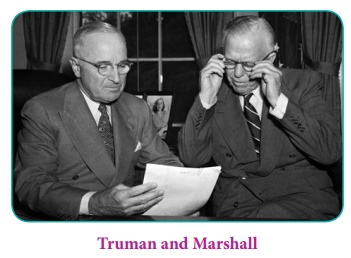
Marshall Plan
With its experience in Greece and Turkey, USA
understood the value of American dollars in containing Communism. So it decided
to move further in the same direction. In June 1947, George C. Marshall, the
Secretary of State under President Truman, came out with an economic plan for all
those European countries which were affected by war. He called it a European
Recovery Programme. Marshall declared, "Our Policy is directed not against
any country or doctrine but against hunger, poverty, desperation and
chaos". European states were provided with financial assistance. Over the
next four years 13,000 million dollars were pumped into western Europe in the
name of Marshall plan. By 1948 sixteen European states and the three Western
zones of Germany set up the Organisation for European Economic Cooperation
(OEEC). Marshall Aid lasted for four years (1948–52). Molotov, the soviet
foreign minister dubbed the Marshall Plan as "dollar imperialism".
In the Soviet view, Marshall Plan was little more
than a ploy to spread American influence.
Molotov Plan
In response to Marshall Plan, USSR set up The Cominform (the Communist Information Bureau) in September 1947. This was an
organisation in which all European communist parties were represented. It
discouraged trade contact between the non-communist countries and tried to
forge ideological and material linkages with its member countries. In 1949,
USSR came out with its economic package known as Molotov Plan. Another
organisation, known as Comecon
(Council of Mutual Economic Assistance), was set up to co-ordinate the economic
policies of USSR and its satellite states.

(b) Military Pacts
Forging strategic alliances by signing military
pacts was another notable strategy used by both the powers to enlarge their
camps. In 1948 Czechoslovakia was the only democratic state in Eastern Europe
and was a buffer between the capitalist bloc and the Soviet Union. In the
elections of May 1948 the Communist party swept the polls. This further alarmed
the western powers.
North Atlantic Treaty Organisation (NATO)
Despite the friendship of the United States,
Western European countries felt insecure. Communist victory in Czechoslovakia
added to their fears.
On 1 November 1952, the United States
successfully detonated “Mike,” the world’s first hydrogen bomb, on the Elugelab
Atoll in the Pacific Marshall Islands. Three years later, on 22 November 1955,
the Soviet Union detonated its first hydrogen bomb.
The Western European countries were now willing to
consider a collective security solution. The representatives of Great Britain,
France, Belgium, the Netherlands and Luxembourg met in Brussels and signed a
treaty in March 1948 which provided for military, political, economic and
cultural collaboration. After sometime USA, Italy, Canada, Iceland, Denmark,
Norway, Ireland and Portugal joined the five Brussels Treaty Powers resulting
in the formation of NATO. Under NATO, all the member states agreed to regard an
attack on any one of them as an attack on all of them and placed their defence
forces under a joint NATO Command Organisation. This collective defence
arrangement applied only to attacks that occurred in Europe or North America
and did not include conflicts in colonial territories. In 1952, Greece and
Turkey were admitted to NATO and West Germany joined in 1955.
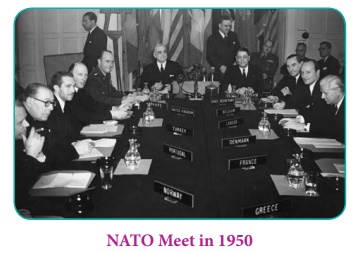
Warsaw Treaty Organisation
When West Germany became a member of NATO, USSR saw
it as a direct threat and decided to make a counter arrangement. In May 1955, a
“treaty of mutual friendship, co-operation and mutual assistance” was signed by
Soviet Union and seven of its European allies. It was named as The Warsaw Pact,
as the treaty was signed in Warsaw, the capital of Poland. The members were
Soviet Union, Albania, Poland, Romania, Hungary, East Germany, Czechoslovakia,
and Bulgaria. The treaty called upon member states to come to the defence of
any member if it was attacked by an outside force. A unified military command
under Marshall Ivan S. Konev of the Soviet Union was set up. The Warsaw Pact
remained valid till 1991, the year of collapse of Soviet Union.
South East Asian Treaty Organisation (SEATO)
In 1949 China turned into a Communist state under
the leadership of Mao. Communism was spreading from China to Korea. Alarmed by
the spread of communism in the Asian region, in September 1951, a tripartite
military alliance was signed between the US, Australia and New Zealand (known
as the ANZUS treaty). In 1954 the US signed a Mutual Defence Treaty with
Nationalist China (Taiwan), providing the latter with American support in the
event of an attack or invasion by Communist China.
In September of 1954, USA, France, Great Britain,
New Zealand, Australia, the Philippines, Thailand and Pakistan formed the
Southeast Asia Treaty Organisation (SEATO). SEATO is seen as an Asian-Pacific
version of NATO. Interestingly only two south-east Asian countries, the
Philippines and Thailand, had taken up membership and the rest of the countries
refused to be part of it. The alliance was headquartered at Bangkok.
SEATO existed only for consultation, leaving each
individual nation to react individually to internal threats. SEATO was not as
popular as NATO. With the end of Vietnam War, SEATO was disbanded in 1977.
Central Treaty Organisation (CENTO)
In February 1955, Iraq and Turkey signed a
"pact of mutual cooperation" at Baghdad. The membership was open to
all countries in the region. In April, Great Britain joined the Pact, followed
by Pakistan and Iran. The aim was to check communist influence. A series of
events took place in Middle East in 1958 which threatened regional stability:
the Egypt–Syria union, revolution in Iraq and civil unrest in Lebanon. In
response to these developments, the United States intervened in Lebanon. The
members of the Baghdad Pact except for Iraq endorsed the US intervention. Iraq
left the pact. As a result, the other signatories of the Baghdad Pact formed
the Central Treaty Organisation (CENTO), moving its headquarters to Ankara,
Turkey. United States continued to support the organisation as an associate,
but not as a member. In 1979, the Iranian revolution led to the overthrow of
the Shah and Iran withdrew from CENTO. Pakistan also withdrew that year after
the organisation ceased to play an active role. CENTO was formally disbanded in
1979.
(c) Propaganda
During the Cold War both the US and the USSR used
propaganda as effective tools to glorify their ideology, while criticising the
opponents values and ideals. Pro-American values were promoted in film,
television, music, literature and art. While the ideology of capitalism was
promoted, communism was condemned both as a political ideology and a social and
economic system by the United States. In USSR propaganda was designed in such a
way that collective work and collective leadership within the socialist frame
were encouraged. Democracy and market economy was dubbed as a façade to mask an
exploitative capitalism.
(d) Espionage
Espionage or spying was a key ploy used by the both
super powers to get information on military secrets and access government
records. During the Cold War both superpowers maintained strong
intelligence-gathering agencies. In the United States the Central Intelligence
Agency (CIA) was established in 1947 and the Soviet Union’s Komitet
Gosudarstvennoy Bezopasnosti (KGB), or ‘Committee for National Security’ was
formed in 1954. The espionage wars fuelled a great amount of suspicion and
hatred, and a huge amount of popular films and novels with spies as heroes and
villains added to it (e.g. James Bond films).
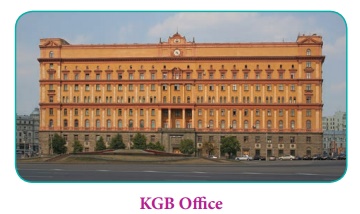
(e) Brinkmanship
Brinkmanship was a term that was constantly used
during the Cold War. The word comes from U.S. Secretary of State John Foster
Dulles. In an interview to Life in
1956, he claimed that, in diplomacy, “if you are scared to go to the brink [of
war], you are lost.” An example of this policy was in 1962 when the Soviet
Union placed nuclear missiles in Cuba. This nearly brought about a nuclear war.
The United States responded by putting a naval blockade around Cuba. Finally,
after much negotiations, the missiles were removed from Cuba.
Brinkmanship is the practice of trying to achieve
an advantageous outcome by pushing dangerous events to the brink of active
conflict. It occurs in international politics, foreign policy, and military
strategy and could involve even the threat of nuclear weapons.
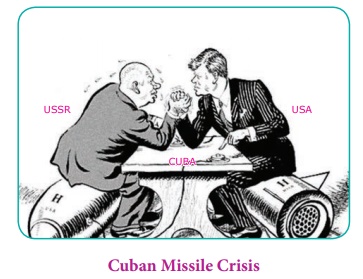
(f) Surrogate Wars
US and USSR engaged in surrogate or proxy wars as
part of Cold War strategy. The Korean War of 1950–53 and the Vietnam Wars of
1955–75 were classic examples of the Cold War period. In both cases Soviet
Union supported the communist government in North Korea and in North Vietnam
and the United States supported South Korea and South Vietnam. These wars resulted
in huge casualties and losses, and turned out to be civil wars as well.
International opinion was mobilised in these wars, and anti-Vietnam protests
made a profound impact on the politics, society and culture of the US and
western Europe.
Related Topics